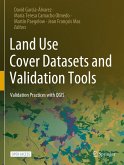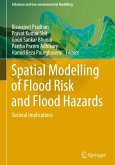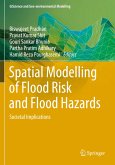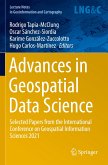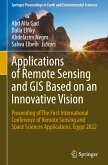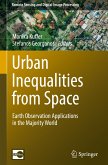Land Use Cover Datasets and Validation Tools
Validation Practices with QGIS
Herausgegeben:García-Álvarez, David; Camacho Olmedo, María Teresa; Paegelow, Martin; Mas, Jean François
Land Use Cover Datasets and Validation Tools
Validation Practices with QGIS
Herausgegeben:García-Álvarez, David; Camacho Olmedo, María Teresa; Paegelow, Martin; Mas, Jean François
- Gebundenes Buch
- Merkliste
- Auf die Merkliste
- Bewerten Bewerten
- Teilen
- Produkt teilen
- Produkterinnerung
- Produkterinnerung
This open access book represents a comprehensive review of available land-use cover data and techniques to validate and analyze this type of spatial information. The book provides the basic theory needed to understand the progress of LUCC mapping/modeling validation practice. It makes accessible to any interested user most of the research community's methods and techniques to validate LUC maps and models. Besides, this book is enriched with practical exercises to be applied with QGIS.
The book includes a description of relevant global and supra-national LUC datasets currently available.…mehr
Andere Kunden interessierten sich auch für
![Land Use Cover Datasets and Validation Tools Land Use Cover Datasets and Validation Tools]() Land Use Cover Datasets and Validation Tools30,99 €
Land Use Cover Datasets and Validation Tools30,99 €![Spatial Modelling of Flood Risk and Flood Hazards Spatial Modelling of Flood Risk and Flood Hazards]() Spatial Modelling of Flood Risk and Flood Hazards138,99 €
Spatial Modelling of Flood Risk and Flood Hazards138,99 €![Spatial Modelling of Flood Risk and Flood Hazards Spatial Modelling of Flood Risk and Flood Hazards]() Spatial Modelling of Flood Risk and Flood Hazards138,99 €
Spatial Modelling of Flood Risk and Flood Hazards138,99 €![Dynamic and Precise Engineering Surveying Dynamic and Precise Engineering Surveying]() Qingquan LiDynamic and Precise Engineering Surveying164,99 €
Qingquan LiDynamic and Precise Engineering Surveying164,99 €![Advances in Geospatial Data Science Advances in Geospatial Data Science]() Advances in Geospatial Data Science97,99 €
Advances in Geospatial Data Science97,99 €![Applications of Remote Sensing and GIS Based on an Innovative Vision Applications of Remote Sensing and GIS Based on an Innovative Vision]() Applications of Remote Sensing and GIS Based on an Innovative Vision134,99 €
Applications of Remote Sensing and GIS Based on an Innovative Vision134,99 €![Urban Inequalities from Space Urban Inequalities from Space]() Urban Inequalities from Space127,99 €
Urban Inequalities from Space127,99 €-
-
-
This open access book represents a comprehensive review of available land-use cover data and techniques to validate and analyze this type of spatial information. The book provides the basic theory needed to understand the progress of LUCC mapping/modeling validation practice. It makes accessible to any interested user most of the research community's methods and techniques to validate LUC maps and models. Besides, this book is enriched with practical exercises to be applied with QGIS.
The book includes a description of relevant global and supra-national LUC datasets currently available. Finally, the book provides the user with all the information required to manage and download these datasets.
The book includes a description of relevant global and supra-national LUC datasets currently available. Finally, the book provides the user with all the information required to manage and download these datasets.
Produktdetails
- Produktdetails
- Verlag: Springer / Springer International Publishing / Springer, Berlin / Universidad de Granada
- Artikelnr. des Verlages: 978-3-030-90997-0
- 1st ed. 2022
- Seitenzahl: 480
- Erscheinungstermin: 18. Juni 2022
- Englisch
- Abmessung: 285mm x 215mm x 32mm
- Gewicht: 1413g
- ISBN-13: 9783030909970
- ISBN-10: 3030909972
- Artikelnr.: 62698802
- Herstellerkennzeichnung
- Springer Nature c/o IBS
- Benzstrasse 21
- 48619 Heek
- Tanja.Keller@springer.com
- Verlag: Springer / Springer International Publishing / Springer, Berlin / Universidad de Granada
- Artikelnr. des Verlages: 978-3-030-90997-0
- 1st ed. 2022
- Seitenzahl: 480
- Erscheinungstermin: 18. Juni 2022
- Englisch
- Abmessung: 285mm x 215mm x 32mm
- Gewicht: 1413g
- ISBN-13: 9783030909970
- ISBN-10: 3030909972
- Artikelnr.: 62698802
- Herstellerkennzeichnung
- Springer Nature c/o IBS
- Benzstrasse 21
- 48619 Heek
- Tanja.Keller@springer.com
David García Álvarez holds Ph.D. and is a postdoctoral researcher at the Department of Geology, Geography and Environment, at the University of Alcalá, Spain. He has previously worked at the University of Granada and the Joint Research Centre of the European Commission. His research interests include land-use cover change mapping and modelling, uncertainty of spatial data, shared economies in the accommodation sector and the analysis of regional and local territorial dynamics. María Teresa Camacho Olmedo holds Ph.D. and is a tenured professor at the Department of Geographical Regional Analysis and Physical Geography, at the University of Granada, Spain. Dr. Camacho Olmedo leads the project entitled Suitability and Uncertainty of Land Use and Cover Maps for the Analysis and Modelling of Territorial Dynamics (INCERTIMAPS), funded by the Spanish Ministry of Ministerio de Ciencia, Innovación y Universidades and the FEDER European Regional Development Fund (ref. PGC2018-100770-B-100) (2019-2021), after successfully completing various other competitive projects since 2003. Her current research includes land-use and land-cover modelling, simulation models and scenarios, and territorial dynamics. She has published numerous scientific papers and books. Martin Paegelow holds Ph.D., is a professor at the Department of Geography, Land Planning and Environment at the University of Toulouse Jean Jaurès, France, and member of Geography of Environment (GEODE) UMR 5602 CNRS laboratory. In 1991, he obtained a Ph.D. in geography and was accredited to supervise research in 2004. He is a specialist in environmental geography and geomatics. His principal research areas are environmental management and geomatic solutions with a special focus on geomatic land change modelling and its validation. He is also strongly committed to the teaching side of his job, and since 2004, has been the co-director of the Master's Degree in Geomatics in Toulouse. Jean Francois Mas holds Ph.D. and is a tenured professor in the Center of Research in Environmental Geography (Centro de Investigaciones en Geografía Ambiental, CIGA) at the National Autonomous University of Mexico (Universidad Nacional Autónoma de México, UNAM). He specializes in the fields of remote sensing, geographical information science, and spatial modelling. His research interests include land-use/land-cover change monitoring and modelling, accuracy assessment of spatial data, forest inventory, and vegetation cartography. He has published more than 70 peer-reviewed scientific publications, advised 9 Ph.D. dissertations, supervised 15 master's degree students, and participated in 35 research projects.
Chapter 1. About this book.- Part I. Concepts, data and validation.- Chapter 2. Land Use Cover mapping, modelling and validation. A background.- Chapter 3. Validation of Land Use Cover maps: a guideline.- Chapter 4. Land Use Cover Datasets: a review.- Part II. Data access and visualization.- Chapter 5. Visualization and communication of LUC data.- Chapter 6. Sample data for thematic accuracy assessment in QGIS.- Part III. Tools to validate Land Use Cover maps: a review.- Chapter 7. Basic and Multiple-Resolution Cross Tabulation to validate Land Use Cover maps.- Chapter 8. Metrics based on a Cross-Tabulation matrix to validate Land Use Cover maps.- Chapter 9. Pontius Jr. methods based on a Cross Tabulation matrix to validate Land Use Cover maps.- Chapter 10. Validation of soft maps produced by a Land Use Cover Change model.- Chapter 11. Spatial metrics to validate Land Use Cover maps.- Chapter12. Advanced pattern analysis to validate Land Use Cover maps.- Chapter 13. Geographically Weighted methods to validate Land Use Cover maps.- Part IV. Land Use Cover datasets: a review.- Chapter 14. Global general Land Use Cover datasets with a single date,- Chapter 15. Global general Land Use Cover datasets with a time series of maps.- Chapter 16. General Land Use Cover datasets for Europe.- Chapter 17. General Land Use Cover datasets for Africa.- Chapter 18. General Land Use Cover datasets for America and Asia.- Chapter 19. Global thematic Land Use Cover datasets characterizing vegetation covers.- Chapter 20. Global thematic Land Use Cover datasets characterizing agricultural covers.- Chapter 21. Global thematic Land Use Cover datasets characterizing artificial covers.- Chapter 22. Supra-national thematic Land Use Cover datasets.
Chapter 1. About this book.- Part I. Concepts, data and validation.- Chapter 2. Land Use Cover mapping, modelling and validation. A background.- Chapter 3. Validation of Land Use Cover maps: a guideline.- Chapter 4. Land Use Cover Datasets: a review.- Part II. Data access and visualization.- Chapter 5. Visualization and communication of LUC data.- Chapter 6. Sample data for thematic accuracy assessment in QGIS.- Part III. Tools to validate Land Use Cover maps: a review.- Chapter 7. Basic and Multiple-Resolution Cross Tabulation to validate Land Use Cover maps.- Chapter 8. Metrics based on a Cross-Tabulation matrix to validate Land Use Cover maps.- Chapter 9. Pontius Jr. methods based on a Cross Tabulation matrix to validate Land Use Cover maps.- Chapter 10. Validation of soft maps produced by a Land Use Cover Change model.- Chapter 11. Spatial metrics to validate Land Use Cover maps.- Chapter12. Advanced pattern analysis to validate Land Use Cover maps.- Chapter 13. Geographically Weighted methods to validate Land Use Cover maps.- Part IV. Land Use Cover datasets: a review.- Chapter 14. Global general Land Use Cover datasets with a single date,- Chapter 15. Global general Land Use Cover datasets with a time series of maps.- Chapter 16. General Land Use Cover datasets for Europe.- Chapter 17. General Land Use Cover datasets for Africa.- Chapter 18. General Land Use Cover datasets for America and Asia.- Chapter 19. Global thematic Land Use Cover datasets characterizing vegetation covers.- Chapter 20. Global thematic Land Use Cover datasets characterizing agricultural covers.- Chapter 21. Global thematic Land Use Cover datasets characterizing artificial covers.- Chapter 22. Supra-national thematic Land Use Cover datasets.


